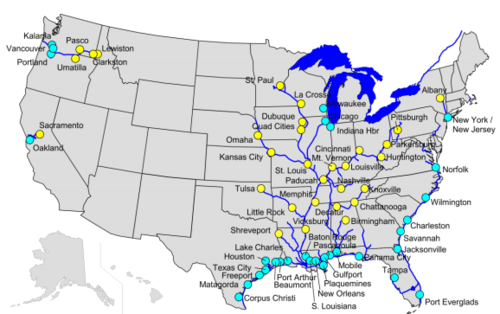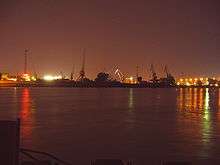Navigability

A body of water, such as a river, canal or lake, is navigable if it is deep, wide and slow enough for a vessel to pass or walk. Preferably there are few obstructions such as rocks or trees to avoid. Bridges must have sufficient clearance. High water speed may make a channel unnavigable. Waters may be unnavigable because of ice, particularly in winter. Navigability depends on context: A small river may be navigable by smaller craft, such as a motor boat or a kayak, but unnavigable by a cruise ship. Shallow rivers may be made navigable by the installation of locks that increase and regulate water depth, or by dredging.
Inland water transport systems
Inland Water Transport (IWT) Systems have been used for centuries in countries including India, China, Egypt, the Netherlands, the United States, Germany, China, and Bangladesh. In the Netherlands, IWT handles 46% of the nation's inland freight; 32% in Bangladesh, 14% in the United States, and 9% in China.
In the United States


What constitutes 'navigable' waters can not be separated from the context in which the question is asked. Numerous federal agencies define jurisdiction based on navigable waters, including admiralty jurisdiction, pollution control, to the licensing of dams, and even property boundaries. The numerous definitions and jurisdictional statutes have created an array of case law specific to which context the question of navigability arises. Some of the most commonly discussed definitions are listed here.
Navigable waters, as defined by the US Army Corps of Engineers as codified under 33 CFR 329, are those waters that are subject to the ebb and flow of the tide, and those inland waters that are presently used, or have been used in the past, or may be susceptible for use to transport interstate or foreign commerce while the waterway is in its ordinary condition at the time of statehood. Section 10 of the Rivers and Harbors Act of 1899 (33 U.S.C. 403), approved 3 March 1899, prohibits the unauthorized obstruction of a navigable water of the U.S. This statute also requires a permit from the U.S. Army Corps of Engineers for any construction in or over any navigable water, or the excavation or discharge of material into such water, or the accomplishment of any other work affecting the course, location, condition, or capacity of such waters. However, the ACOE recognizes that only the judiciary can make a definitive ruling as to which are navigable waters.33 CFR 329
For the purposes of transferring property title into public property, the definition of a Navigable waterways closely follows 33 CFR 329. For the purpose of establishing which river is public and therefore state-owned, what is navigable is a constitutional question defined by Federal case law. see PPL Montana v Montana (2012). If a river was considered navigable at the time of statehood, the land below the navigable water was conveyed to the state as part of the transportation network in order to facilitate commerce. Most states retained title to these navigable rivers in trust for the public. Some states divested themselves of title to the land below navigable rivers, but a federal navigable servitude remains if the river is a navigable waterway. Title to the lands submerged by smaller streams are considered part of the property through which the water flows and there is no public right to use private property.
The scope of the Federal Energy Regulatory Commission (FERC) authority was granted under the Federal Power Act, 1941 (16 U.S.C 791). Such authority is based on congressional authority to regulate commerce; it is not based exclusively on title to the riverbed [16 U.S.C. 796(8)] or even navigability. Therefore, FERC's permitting authority extends to the flow from non-navigable tributaries in order to protect commerce downstream, [US v. Rio Grande Irrigation, 174 U.S. 690, 708 (1899)],[Oklahoma v. Atkinson, 313 US 508, 525].
Also, the Clean Water Act has introduced the terms "traditional navigable waters," and "waters of the United States" to define the scope of Federal jurisdiction under the Clean Water Act. Here, "Waters of the United States" include not only navigable waters, but also tributaries of navigable waters and nearby wetlands with "a significant nexus to navigable waters"; both are covered under the Clean Water Act. The Clean Water Act expands a more limited jurisdiction beyond "navigable waters" sometimes extending limited federal jurisdiction under the Act over private property. Because jurisdiction under the Clean Water Act extends beyond public property, the broader definitions of "traditional navigable" and "significant nexus" used to establish the scope of authority under the Act are still ambiguously defined and therefore open to judicial interpretation as indicated in two U.S. Supreme Court decisions: "Carabell v. United States" and "Rapanos v. United States".[1] However, because authority under the Act is limited to protecting only navigable waters, jurisdiction over these smaller creeks is not absolute and may require just compensation to property owners when invoked.
Finally, a water-body is presumed non-navigable with the burden of proof on the party claiming it is navigable. The U.S. Forest Service considers a waterbody not navigable until is adjudicated otherwise. see Whitewater v. Tidwell 770 F. 3d 1108 (2014). Therefore, and public rights associated with navigability cannot be presumed to exist without a finding of navigability.
Examples
Inland water transport system in India
In India there are currently three National Waterways totaling a distance of 2921 km. They are:
- Haldia Allahabad stretch of the Ganges Bhagirathi Hooghly river system (1620 km) in October 1986 as National Waterway 1
- Saidiya Dhubri stretch of the Brahmaputra river system (891 km) in September, 1988 as National Waterway 2
- Kollam-Kottapuram (in Kerala) stretch of West Coast Canal (410 km) along with Champakara canal and Udyogmandal canal in February, 1993 as National Waterway 3
It is estimated that the total navigable length of inland waterways is 14500 km. A total of 16 million tonnes of freight is moved by this mode of transport.
Advantages of inland water transport systems

Waterways provide enormous advantages as a mode of transport compared to land and air modes of transports.
- Cheaper capital cost - Nature has already done the initial engineering work for the transportation infrastructure, the cost of developing an inland waterway is 5-10% of the cost developing an equivalent railway or a four-lane expressway. This varies a lot, depending on whether the waterway is naturally navigable, whether only ports are needed, or whether a canal and locks are needed.
- Cheaper maintenance cost - The maintenance cost of an inland waterway is only 20% of the maintenance cost of an equivalent roadway.
- Greater fuel efficiency (low cost of transportation) - It is estimated that 1 liter of fuel can move 105 ton-km by inland water transport. Whereas the same amount of fuel can move only 85 ton-km by rail and 24 ton-km by road. By air, it is even less.
- Easy integration with sea transport - Inland water transport can easily integrated with Sea transport and hence it reduces the extra cost required for land-sea or air-sea transport interface infrastructure development. It also reduces the time taken to transfer the goods to and from sea transport vessels.
Disadvantages of inland water transport systems
- Low availability of inland waterways - As mentioned above, there are numerous criteria for a water body to be navigable. Out of the total inland water body available in the world, only a very low percentage of it is potentially navigable.
- Low speed - Water transport as a whole is much slower than its road, rail, or air competitors.
See also
- Canal
- Classification of European Inland Waterways
- Glossary of nautical terms
- Inland harbor
- Inland sea (geology)
- Inland waters of Azerbaijan
- Inland Waterways Association, UK
- Inland Waterways Association of Ireland
- Inland waterways of India
- Inside Passage
- Lake freighter
- List of canals in France
- Merchant vessel
- Ship transport
- Watercraft
- Waterway